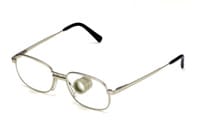Focus On Low Vision
Driving with Bioptic
Telescopes
By Stephanie K. De Long
For many patients with age-related macular degeneration and other vision-related conditions, the loss of central visual detail also signals the end to one of the last bastions of independence--driving. More and more doctors are, however, showing interest in bioptic telescopes as a way to help some of their patients.
The traditional bioptic solution is to attach a small telescope to spectacles near the top of the carrier lens. By tilting the head downward, the wearer is able to see road signs and lights as well as potential hazards.
Who is a good candidate for driving with bioptics? According to the American Optometric Association (AOA) and the BiOptic Driving Network (BDN), a non-profit organization founded in 2001, "Persons eligible for licensure with bioptic telescopes are individuals who are able to see large objects through their carrier lenses, but who may not be able to discern details or read signage from great distances."
|
|
|
|
PHOTO COURTESY LIGHTHOUSE INTERNATIONAL |
|
STATE REGS
How have states responded to driving with vision loss? When it comes to getting behind the wheel, most states mandate a visual acuity of no worse than 20/40 to obtain an unrestricted driver's license. For people outside those parameters, there are a variety of restricted licenses that limit drivers to specific situations, such as daylight only, no highway, or even limited-distance driving.
When it comes to driving with bioptics, however, states agree on very little. On paper, anyway, 28 states currently allow driving with bioptic telescopes and issue a Bioptic Telescopic System License. There is such a lack of uniformity among the individual states, however, that no two have the same regulations for issuing a license.
According to research conducted by Eli Peli, MS, OD, from the Schepens Eye Research Institute at Harvard University, 13 of the states don't allow night driving with a bioptic. In what appears to be an example of how cost constraints can supersede safety concerns, only 18 states require a special driving test, and only an even dozen mandate any driver training before getting behind the wheel with bioptics. Though a few states place restrictions on the maximum magnification that is allowable, none sets any parameters for acceptable through-the-telescope fields of view.
Though driving with bioptic telescopes is not new, some of the interest in and controversy around bioptics in driving is definitely new. An increasing number of low vision suppliers are carrying products in this market and also provide tools for training patients with bioptics. At least two states report plans to conduct road tests to determine the safety and feasibility of allowing drivers to get behind the wheel with bioptics. And the AOA is calling for "a rational approach to consideration of individuals adapted to bioptic telescopic spectacles who apply for driver's licensure."
|
|
|
|
PHOTO COURTESY ESCHENBACH |
The most visible sign of increased interest, however, has been the formation of the BiOptic Driving Network, a not-for-profit network concerned with developing and advancing the use of bioptics for driving, with active groups in several countries. In addition to patient, advocacy, and legislative policy change sections, the group works with major organizations in the U.S. and abroad and sponsors an internet-based forum for eyecare professionals involved in the category (www.biopticdriving.org). Next year, it will co-sponsor, along with the International Society for Low-vision Research and Rehabilitation (ISLRR), the International BiOptic Driving Conference in London from June 18 through 20.
SAFETY STATS
Though several decade-old studies reported no correlation between limited field of vision and increased accidents, one UK study, conducted in 1983, did. Those inconsistent findings, combined with the age of existing studies, have made the push for new testing a priority.
According to Dr. Kent Higgins, a Lighthouse International research investigator, "Nearly all previous studies that have correlated visual acuity and accidents in samples of licensed drivers have found that less than one percent of the variance in the accident database can be explained by acuity variations."
The need, according to the Lighthouse International's "Driving and Mobility" report, is for new methodologies to determine "the minimal visual requirements (e.g., visual acuity, visual fields) for the different components on the overall driving task--such as steering, reading signs, and recognizing road hazards." Such research is now underway. It will, according to the Lighthouse, "provide important evidence concerning the relationship between vision loss and driving performance and, in addition, the efficacy of the proposed low vision devices for improving related mobility."
Whether it's testing driver safety or training patients on bioptic devices, the ultimate goal of all involved is the same--to maximize both patient mobility and driving safety. And the key to making it all work is not the device itself, but the training that goes with it.





